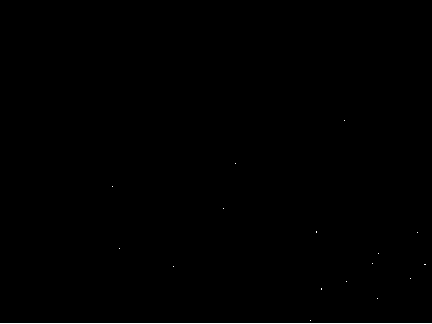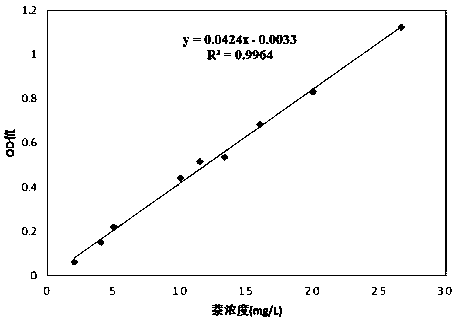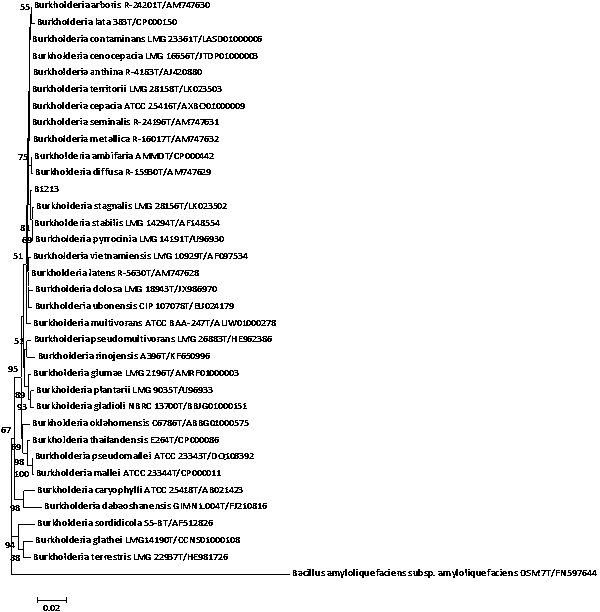Application of Burkholderia pyrrole and method for degrading naphthalene
A technology of Burkholderia pyrrole, Holderella, applied in the directions of microorganism-based methods, applications, chemical instruments and methods, etc., to achieve the effects of simple operation, high degradation rate, and short degradation cycle
- Summary
- Abstract
- Description
- Claims
- Application Information
AI Technical Summary
Problems solved by technology
Method used
Image
Examples
Embodiment 1
[0031] Identification of Example 1 bacterial strain B1213
[0032] Strain B1213 was isolated from soil, and its morphology was as follows figure 1 As shown, it is a rod-shaped Gram-negative bacteria that cannot form spores. Genomic DNA was extracted, and the genomic DNA was subjected to polymerase chain reaction (Polymerase Chain Reaction, PCR) using 16s rDNA and BCR1 primers to propagate specific DNA sequences, and the National Center for Biotechnology Information (National Center for Biotechnology Information, NCBI) database for strain comparison.
[0033] (1) 16S rDNA sequence analysis:
[0034] 16s rDNA forward primer 27F: 5'-AGA GTT TGA TCC TGG CTC AG-3', as shown in SEQ ID NO.1;
[0035] 16s rDNA reverse primer 1492R: 5'-ACG GTT ACC TTG TTA CGA CTT-3', as shown in SEQ ID NO.2;
[0036] The amplified 16S rDNA sequence is shown as SEQ ID NO: 3, and the full length of the sequence is 1411bp. The amplified 16S rDNA sequence was compared with the gene sequence of relate...
Embodiment 2
[0042] Example 2 Preparation of Burkholderia pyrrole B1213 Liquid Shake Flask Culture Solution
[0043](1) Slant culture: Burkholderia pyrrole B1213 was inoculated on the slant medium and cultured at 40° C. for 48 hours to obtain the slant strain. The slant medium used contained the following ingredients per 1L: 2.0g glucose, 1.0g peptone, 0.5g yeast extract, 1.8g agar, the rest of distilled water, neutral pH, and sterilized at 115°C for 20 minutes.
[0044] (2) Take the slant strain and inoculate it into the sterilized seed culture medium, and incubate at constant temperature and shaking for 24 hours under the conditions of 175 rpm and 30°C to obtain the seed culture medium. The seed culture medium contains the following ingredients per 1L: 0.5g of ammonium sulfate, 4.0g of sodium chloride, 0.5g of potassium phosphate trihydrate, 0.4g of magnesium sulfate heptahydrate, 15g of agar powder, 5g of yeast extract, and the remainder of distilled water. Quantity, pH7.0, sterilized ...
Embodiment 3
[0046] Example 3 NAP standard curve formulation and content determination
[0047] (1) Prepare 400mg / L naphthalene mother liquor with n-hexane as solvent, dilute 20 times, 25 times, 30 times, 35 times, 40 times, 80 times, 100 times, 200 times respectively for later use, take 2.5mL of different dilution factors The naphthalene solution is placed in a 3mL quartz cuvette, and the absorbance value under the wavelength of 275nm is measured respectively with an ultraviolet spectrophotometer, and the ordinate is used as the absorbance value, and the concentration of naphthalene is used as the abscissa to draw a standard curve; the standard curve is as follows figure 2 Shown; and then obtain the absorbance value-concentration equation: y=0.0424x-0.0033, x is the concentration of naphthalene, and y is the absorbance value.
[0048] (2) Take 2.5mL of the fermentation broth obtained in Example 2 and place it in a 3mL quartz cuvette, measure the absorbance at 275nm wavelength with a UV s...
PUM
 Login to View More
Login to View More Abstract
Description
Claims
Application Information
 Login to View More
Login to View More - R&D
- Intellectual Property
- Life Sciences
- Materials
- Tech Scout
- Unparalleled Data Quality
- Higher Quality Content
- 60% Fewer Hallucinations
Browse by: Latest US Patents, China's latest patents, Technical Efficacy Thesaurus, Application Domain, Technology Topic, Popular Technical Reports.
© 2025 PatSnap. All rights reserved.Legal|Privacy policy|Modern Slavery Act Transparency Statement|Sitemap|About US| Contact US: help@patsnap.com



